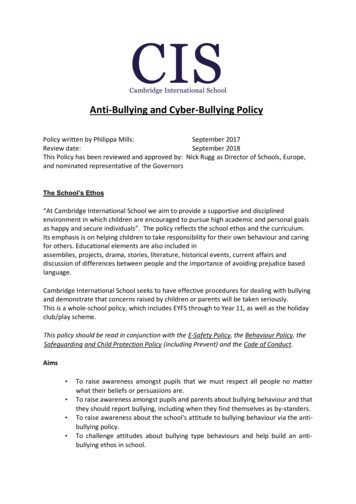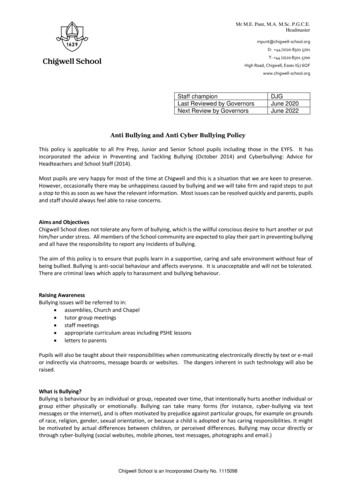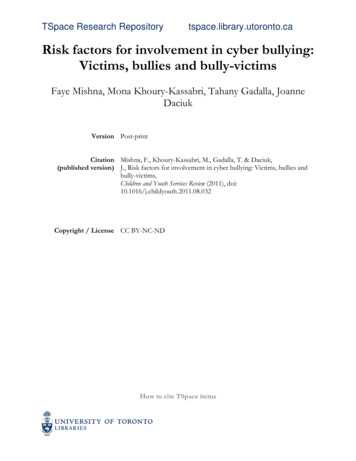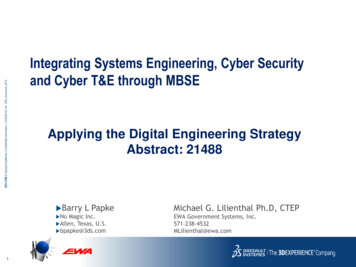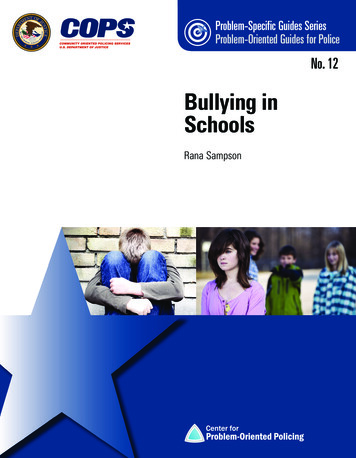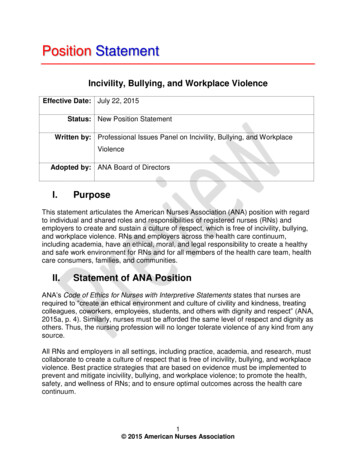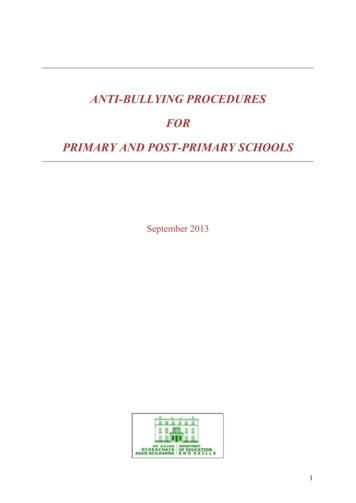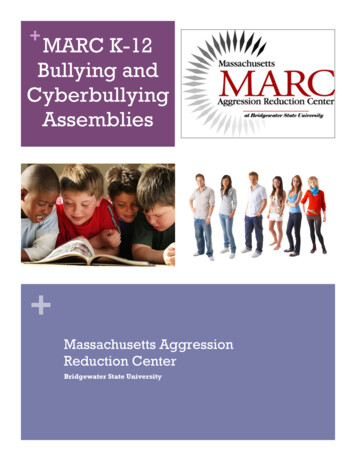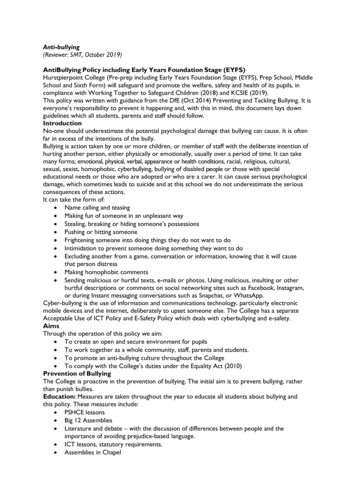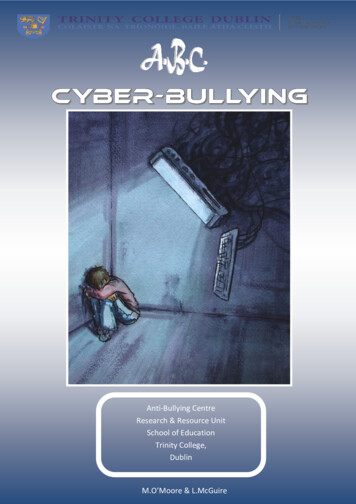
Transcription
Cyber-BullyingAnti-Bullying CentreResearch & Resource UnitSchool of EducationTrinity College,DublinM.O’Moore & L.McGuire
CONTENTSWHAT IS CYBER-BULLYING?1CYBER-BULLYING Vs. TRADITIONAL BULLYING1-2TYPES OF CYBER-BULLYING3-4WHO CYBER-BULLIES?4-5EFFECTS OF CYBER-BULLYING5SIGNS OF CYBER-BULLYING6TOP TIPS TO PREVENT CYBER-BULLYING6-8ADVICE FOR CHILDREN & YOUNG PEOPLE9 - 10SCHOOLS & CYBER-BULLYING10WHAT CAN SCHOOLS DO ABOUT CYBER-BULLYING11 - 12LEGISLATION PERTAINING TO CYBER-BULLYING12A.B.C - IT’S HISTORY & AIMS13A.B.C - SERVICES PROVIDED14THE A.B.C. TEAM15USEFUL WEB ADDRESSES ON CYBER-BULLYING16USEFUL MOBILE PHONE INFORMATION17PUBLICATIONS & RESOURCES18 - 19
1What is Cyber-Bullying?Cyber-bullying occurs when a person or group makes use of electroniccommunication devices, commonly mobile phones or the internet, todeliberately harass, intimidate or humiliate another individual.Cyber-bullying can consist of threats, insults, embarrassing or humiliating messages, pictures or video clips, defamation or impersonation.Insults can be prejudice-based, expressing racist, sexist or homophobicsentiments.In Ireland almost one in five children and teenagers are involved incyber-bullying either as victims, bullies or both.Over 57% of incidents originate from the use of mobile phones, with text-messaging being the most common form of cyber-bullying both in andout of school.Differences between cyber-bullying &Traditional bullyingCyber-bullying is distinct form of bullying; however, it is just as damagingas traditional bullying. Unlike traditional forms it can involve a once-offevent. This is because a single malicious posting of a comment or imageonline can be seen by multiple viewers instantly so the victim’s experience of being bullied is repetitive. Even if this comment or image isremoved it may still have been viewed by literally thousands of viewersleading to even greater embarrassment for the victim.The cyber-bully has the capacity to reach their victim at anytime andanywhere so there is no safe haven, meaning the bullying can berelentless. The fact that the internet has a much wider audience onlyadds to the victim’s feelings of humiliation and despair.
2Cyber-space is virtually free from adult supervision, which means thatthey often have no idea that their child is being cyber-bullied, this iscompounded by the fact that children and young people’s knowledge oftechnology is often far more advanced than that of their parents orteachers. Recent research has shown, like traditional bullying, victimsof cyber-bullying do not tell an adult; instead, they are far more likely tosend an angry message back or talk to a friend about it.Another facet of cyber-bullying is that it is anonymous. Sometimes thevictim does not know who their bully is; online a bully can assume a fakeidentity, make abusive, nasty comments and never have to fear beingheld accountable. This causes even greater anxiety, insecurity andmistrust for the victim who wonders who is responsible for the bullying.The bully may not even live on the same continent as the individualbeing bullied, such are the advances in technology.Recent research also suggests that girls are over-represented in certaintypes of cyber-bullying, such as abusive texts, calls from mobile phones,nasty things posted about someone online and nasty, aggressive emails.Parents and teachers of girls need to be particularly vigilant aboutinvolvement in these kind of behaviours.
3Types of cyber-bullyingText Message Bullying. also known as SMS bullying, is the most common form ofcyber-bullying. Studies have shown that text-message bullying is thetype of cyber-bullying that is most frequently experienced. Text-messagebullying may be considered to be as potentially psychologically dangerous as any other form of bullying. These text messages can be abusiveand threatening in nature.Phone call bullying via mobile phones. is when individuals make threatening or abusive phone calls to otherindividuals for the purpose of bullying. Mobile phones can also be usedto make silent phone-calls in order to intimidate the recipient. This caninvolve the theft and use of another’s phone in an attempt to make himor her appear culpable.Bullying by photographs or video clips via mobile phone cameras. which involves either the taking, sending, or publication of photographs or video clips via mobile phone cameras. One form of this is‘happy slapping’ attacks, in which individuals may film themselves attacking others such as random people, or targeted individuals. Thesephotographs or video-clips may be posted on websites such as YouTubeor Facebook and cause great embarrassment and humiliation to theindividual being bullied.Email bullying. involves the sending of abusive emails and is another common form ofcyber-bullying inside and outside of schools.Chat-room bullying. includes sending and receiving threatening, or abusive messages inchat rooms and is a common form of cyber-bullying because the bulliesmay be able to remain anonymous. It also allows for the bullying to bewitnessed by other individuals in the chat room.
4Trolling. an internet troll is someone who posts inflammatory comments oninternet sites sometimes with the intention of inciting others to abuse.Internet trolls are either looking for a target to be emotionally affectedby their comments or attempting to stir others into a verbal firestorm.They usually remain anonymous.Bullying via websites. this may include the use of defamatory blogs, personal websites,on-line personal polling sites, general polling sites and also the misuse ofcertain social networking sites, such as Facebook and YouTube, for thepurposes of bullying. Website bullying may have the same impact astraditional bullying, and because of the more frequent use of socialnetworking sites by teenagers, there is greater potential for increasingcyber-abuse.WHO CYBER-BULLIES?Power Hungry Bully (Proactive). is often someone who has little power or voice in real life. Bullies wantto show their authority over others and show that they are powerfulenough to control others, but since they do not have power in real lifethey hide behind the anonymity of the internet in order to exert theirpower over others. This type of bullying is usually done a one-on-onebasis. Friends and family of this type of bully are typically not aware thatthey are bullying others.
5Vengeful (Reactive). this type of cyber-bully does not believe him/herself to be a bully. He/she believes the victim is at fault and that he/she is doing the right thingand protecting themselves or others. This is common when a victimof bullying becomes the bully themselves in retaliation to their experience of being bullied.‘Mean Girls’ (Proactive). usually occurs when the bully is bored or looking for entertainment. Inthis case, the bully is usually a female and it is usually done in groups.This kind of cyber-bullying typically involves an audience. The bullywants others to know they have the power to bully others and wantthemselves to be known.‘Inadvertent’ Cyber-bully (Reactive). this type of cyber-bully does not believe themselves to be a bully at all.They usually do not act intentionally, but rather without thinking of theconsequences of their actions. They typically act in response to something that they have seen or heard that hurt or bothered them. Theymay have even been bullied themselves. These types of bullies commonly do not understand the seriousness of their actions.THE EFFECTS OF CYBER-BULLYING?Some of the effects of cyber-bullying include:StressAnxietyAngerSleep problemsBecoming withdrawnAngerDepressionThoughts of suicideAggressive behaviourLoss of confidence & self-esteemLoss of a sense of securityLack of motivation & energyAlcohol, drug or substance abuse
6SIGNS OF CYBER-BULLYINGSome of the signs that a child is being cyber bullied include:Signs of emotional distress during or after using the internetUnexpectedly stops using the computerWithdrawal from friends and activitiesAvoidance of school or group gatheringsSlipping grades and acting out in anger at homeChanges in mood or behaviourChanges in sleep or appetiteLower confidence and self-esteemVisible signs of anxiety but refusal to say what is wrongBecoming isolatedTEN TOP TIPS TO DEAL WITH CYBER-BULLYINGBy Prof. Mona O’Moore in Association with Carphone Warehouse1. Inform yourself about mobile phone and internet use and safety.Carefully read your child’s mobile phone manual and take note of howto contact the phone’s service provider should it be necessary to make acomplaint.2. Make sure your child or teen understands the importance of internet and mobile safety. Do not take it for granted that your child or teenknows how to avoid the pitfalls of electronic communication. Warnthem of the pitfalls of putting photos of themselves on the internet orto indiscriminately share their name, address, phone number or otherpersonal information online. Ask them are they happy to put the sameinformation in a shop window as they pass around amongst their friends.
73. Inform yourself about blocking devices which will help to block unwanted and abusive calls. The vMad Bully Stop application allows yourchild and teenager to control who calls or sends them texts. It also enables you and your child to view the content of any blocked text.4. Encourage open and non-judgemental communication with yourchild or teenager. Talk to your child about their online friends and activities in the same way you would their traditional friendships and activities. Ask if they have seen abusive or hurtful texts or postings. Ask themwhat they would do if they did. If there is anything you do not understand about their mobile phone or internet activities ask them to showyou.5. Key advice for your child or teenager if targeted.Do not feel ashamed. The shame lies with the bully.Do not reply to abusive or hurtful messages.Save the message.Report the threatening or offensive behaviour to a parent orteacher and/or contact the service provider (through its CustomerCare or Report Abuse facility). If the cyber-bullying is verythreatening and serious contact your local Gardai.Block the sender.6. Share evidence of cyber-bullying with the school. Most often thechildren who cyber-bully also engage in traditional face-to-face bullyingso its important the school gets to know about it so that they can apprehend the bullies. With cyber-bullying you will have the advantage ofbeing able to show copies of the offensive messages, pictures or videoclips used to humiliate or embarrass your child or teen.7. Make sure your child or teenager understands that you disapproveof cyber-bullying. It is important that children and teens learn torespect each other and therefore they should be told to avoid engagingin cyber-bullying for whatever reason that might tempt them to beabusive and hurtful to others. Should you as a parent be informed oftheir inappropriate behaviour, impress upon them that one should not
8do onto others what one would not like done to oneself. It is vital alsothat you try to find the reason for their cyber-bullying behaviour. In thatway you can help them overcome it.8. Administer consequences for breaking the rules of cyber-safety. Ifnecessary apply ‘the yellow card, red card’ philosophy and as a corrective measure reduce their allowance for mobile phone credit or the timespent on the computer.9. Have your child or teen understand that cyber-bullying can lead to acriminal offence. Any text message or internet communication that isgrossly threatening, offensive or harasses another person could be investigated by the Gardai and result in prosecution.10. Keep up to-date with the advances in electronic communication.Do not be afraid to show your ignorance. Remember we are all ignorantabout certain things. Listen and learn from your child or teenager andtogether you can log onto websites to learn about the positive uses ofelectronic communication as well as the most effective strategies toprevent and tackle bullying and cyber-bullying.
9Advice for children & young people onhow to handle cyber-bullyingand be cyber-safeIf you are being cyber-bullied, it is important to remember thefollowing:Do not ignore the bullying, tell someone you trust.Remember it’s not about you. Often people who bully others doso to make themselves feel better because they are unhappy. Donot blame yourself, it is not your fault.Do not delete the offensive text, email, phone-call, video-clip orimage, this should instead be kept as evidence.Do not respond to unwanted texts, instead turn off your phone fora few days or change your number.If you are receiving unwanted calls, do not hang up straight awayas this may feed the callers wish to scare you, instead walk awayand hang up a few minutes later.Think about purchasing an application which would allow you tocontrol who calls or sends you texts, such as vMad Bully Stop fromCarphone Warehouse.Some tips on staying cyber-safe:FacebookDo not accept ‘friend invites’ from people you do not know; exercisethe same caution you would with a stranger you meet on the street.Make sure your privacy settings are so that only your friends canview your personal information and photos. If your profile is set to‘public’ anybody can view your photos and anything you or yourfriends write online.
10Be sensible about what personal information you include in yourprofile. Keep it general and exercise great caution in listing details ofyour home address, mobile number, email address, the school orsports club you attend.Do not assume just because your profile is ‘private’ that your conversations are too. If someone hacks into your friends profile, then theywill also be able to view all your information.Make it a rule of thumb not to divulge anything online that youwould not be happy to say out loud in a crowded room.General cyber-safetyDo not respond to ‘flames’ (unwanted emails) or open files frompeople you don’t
Cyber-bullying occurs when a person or group makes use of electronic communication devices, commonly mobile phones or the internet, to deliberately harass, intimidate or humiliate another individual. Cyber-bullying can consist of threats, insults, embarrassing or humiliat-ing messages, pictures or video clips, defamation or impersonation. Insults can be prejudice-based, expressing racist .
